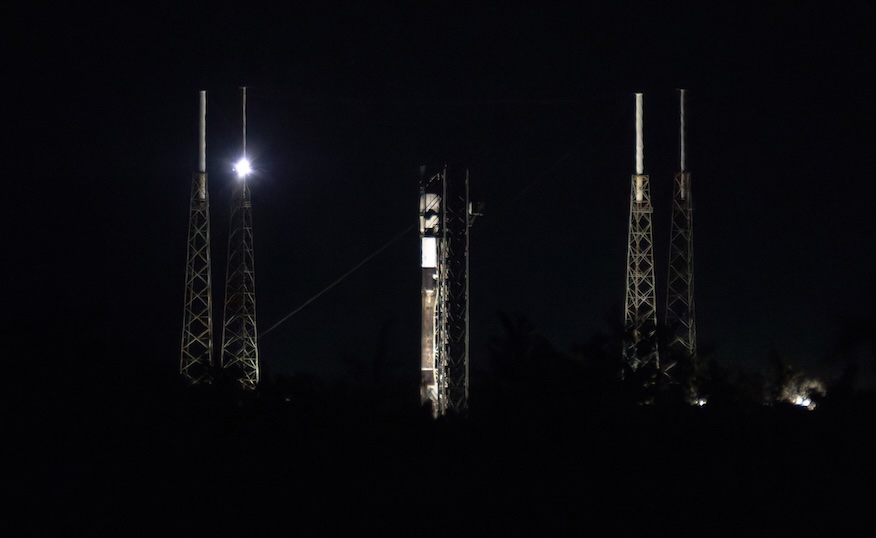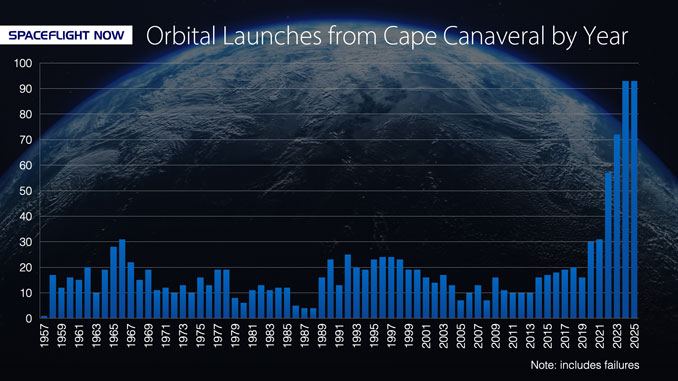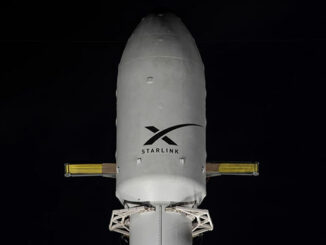
The busiest spaceport in the world is set to break another record on Monday night. Weather permitting, the launch of a SpaceX Falcon 9 rocket will be the 94th launch for an orbital class rocket from Florida, surpassing the total achieved in 2024.
The mission on deck is Starlink 6-87, which will add another 29 broadband internet satellites to the company’s mega-constellation in low Earth orbit. SpaceX is targeting the liftoff from pad 40 at Cape Canaveral Space Force Station at 10:21 p.m. EST (0321 UTC).
The launch was originally scheduled about five hours earlier in the day, but it was pushed later because the Federal Aviation Administration is limiting commercial launches to between the hours of 10 p.m. and 6 a.m., due to the shortage of air traffic controllers during the government shutdown. Launches add significantly to the workload of air traffic controllers due to the need to divert flights away from the launch danger area.
Spaceflight Now will have live coverage of the mission beginning about an hour prior to liftoff.
The 45th Weather Squadron forecast a 60 percent chance for favorable weather during the launch window thanks to a “strong cold front” moving across the state on Monday. Meteorologists citied concerns from strong winds at liftoff as well as upper-level wind shear and somewhat questionable weather in the booster recovery zone near the Bahamas.
“The front itself will cross the region Monday morning, ushering in a blast of strong northwesterly winds and chilly temps that will linger through at least the first half of Tuesday,” launch weather officers wrote. “As a result, the main concern for the primary launch window will be liftoff winds.”
SpaceX is using B1096 for the Starlink 6-87 mission, one of the newer Falcon 9 boosters in its fleet. Monday’s launch will be its third flight following KF-01 for Amazon’s Project Kuiper and NASA’s IMAP rideshare mission earlier this year.
Less than eight minutes after liftoff, B1096 will perform an autonomous landing attempt on the drone ship, ‘Just Read the Instructions’. If all goes well, this will be the 141st landing on this vessel and the 532nd booster landing to date.
Records are made to be broken
For more than half a decade, Florida’s spaceport, a combination of both NASA’s Kennedy Space Center and Cape Canaveral Space Force Station, have been steadily increasing the number of orbital launches, thanks in large part to a yearly ramp up in flights from SpaceX.
Between its two Falcon launch pads, Launch Complex 39A and Space Launch Complex 40, SpaceX will have launched 88 times after flying the Starlink 6-87 mission, about 95 percent of the launches from Florida’s Space Coast.
Falcon launch #130 for 2025. The rolling 365 launch total is 166 launches!
Notable records from this morning:
* Fastest launch to launch from the same American Launch Pad at 55 Hrs, 29 minutes and 9 seconds
* Fastest TE roll in to hangar for booster integration to launch at 12… https://t.co/kgrHZ7yXD5— Kiko Dontchev (@TurkeyBeaver) October 16, 2025
The impact of some of those launches was reflected in October’s monthly CEO report delivered by Capt. John Murray, to the Port Canaveral Commission on Oct. 22. He noted that for all of Fiscal Year 2025 (Oct. 1, 2024 – Sept. 30, 2025) that there were 90 boosters brought into port along with 194 payload fairings, which he described as “quite significant.”
Port Canaveral doesn’t explicitly break down its listing of “Space Component Recoveries” in its report. Presumably, these numbers reflect just SpaceX components, but Spaceflight Now did reach out to Port Canaveral to seek clarification.
The ramp up in launch cadence required both increased agility on the part of launch operators, like SpaceX and United Launch Alliance as well as from those who manage the Eastern Range.
Ahead of the Aug. 4, 2022, launches of both the SBIRS GEO-6 and the Korea Pathfinder Lunar Orbiter by ULA and SpaceX respectively, Spaceflight Now Reporter Will Robinson-Smith spoke with members of the 1st Range Ops Squadron (1 ROPS) in his capacity as a reporter for Spectrum News 13 at the time.
Back then, a double launch day was something that hadn’t been achieved in Florida since the 1960s. U.S. Space Force 2nd Lt. Christian Jackson said that a ramped up launch cadence was “something that we train for every week” in preparation for a more airport-like flight environment.
“Just a few years ago, they were launching maybe 12 rockets in a year. We’ve got about 60 plus on the manifest to finish out this year and there are hopes of possibly doing up to 100 launches next year,” Jackson said in 2022. “So, if we want to reach those numbers, we’re definitely going to get to that point where we’re launching over one in a day.”
There have been many double launch days since then, with the most recent being September 25, which saw the launches of the Starlink 10-15 mission on a Falcon 9 rocket and the Kuiper Atlas 03 mission on an Atlas 5 551 rocket.
Leadership at the Cape has been working to increase payload processing facility capacity to allow for further ramp up of missions, with facilities like one dedicated to Amazon’s Kuiper satellites coming online earlier this year.





Be the first to comment